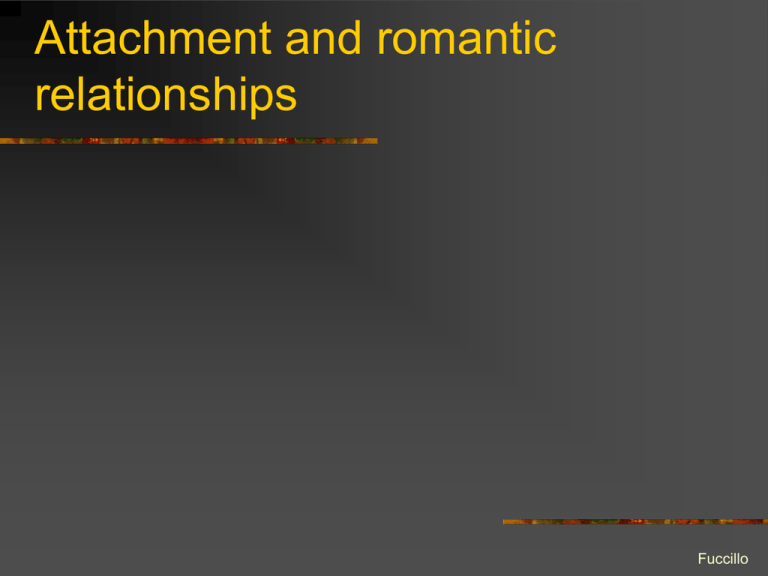What attachment processes are active in adulthood? How do they impact intimate relationships?
advertisement

Attachment and romantic relationships Fuccillo Attachment: From the cradle to the grave Hazan & Shaver, 1994 Fuccillo Attachment Review Fuccillo Can I count on my attachment figure to be available/responsive? Yes – Secure No – Insecure/Avoidant Exploration Defensiveness Maybe – Insecure/Resistant Anxiety Fuccillo Three features Fuccillo Attachment development Phase Parents Infancy Proximity Safe haven Secure base Early childhood Late childhood/ adolescence Adulthood Peers Proximity Safe haven Secure base Proximity Safe haven Secure base Proximity Safe haven Secure base Fuccillo Attachment formation to partner Fuccillo Relationship Development Sexuality Care-giving Attachment Relationship formation Proximity Safe haven Proximity Safe haven Relationship development Proximity Safe haven Secure base Proximity Safe haven Secure base Attraction Proximity Fuccillo Fundamental questions • What makes relationships satisfying or enduring? – how well they meet basic needs for comfort, care, sexual gratification • …at least compared to alternatives – fear of separation from attachment figure activates attachment system • even if needs not being met • Why do relationships dissolve? – relative importance of basic needs changes • lack of caregiving exposed when sexual passion declines • What are the reactions to relationship breakup? – attachment system activated • separation-protest to seek proximity – sadness & detachment – re-attachment to another • sometimes premature Fuccillo Individual differences • Predictable strategies for maintaining felt security – Inconsistent responsiveness anxious/ambivalent attachment • preoccupation with keeping others close (fall in love easily, early selfdisclosure) • intense expression of distress (view partners as insufficiently responsive) • diminished exploratory behavior – Consistent unresponsiveness avoidant attachment • avoiding intimacy • compensatory engagement in non-social activities (work) • regulation anxiety through other means (uncommitted sex, substance use, distraction) • Gender – no differences in attachment styles – females more oriented to caregiving, males to sex Fuccillo Parent Peer Partner Attachment representations of the three relationships are distinct yet related Attachment style Parent - Peer (friend) concordance Peer – Partner (romantic) concordance Not Parent – Partner Peer relationships appear to be a mediator Why? Furman, W., Simon, V. A., Shaffer, L., & Bouchey, H. A. (2002). Adolescents' working models and styles for relationships with parents, friends, and romantic partners. Child Development, 73(1), 241-255. Fuccillo Adolescents' anxiety & dating : The role of friends & romantic partners • Adolescents' social relationships can support or interfere with the development of successful romantic relationships. • Adolescents with fewer other-sex friends, less positive & more negative interactions with best friends high levels of dating anxiety. • Never having a romantic relationship, no current romantic partner, and less positive & more negative interactions with their romantic partners higher levels of dating anxiety. • Messinger La Greca, Annette M .; Mackey, Eleanor Race Journal of Clinical Child and Adolescent Psychology. Vol 36(4),2007, 522-533. ADOLESCENT … RELATIONSHIPS: DO THEY PREDICT SOCIAL ANXIETY AND DEPRESSION? But relational victimization and negative interactions in best friendships predicted high social anxiety. Affiliation with a high-status peer crowd afforded some protection against depressive affect But relational victimization and negative qualities of best friendships and romantic relationships predicted depressive symptoms. Some moderating effects for ethnicity were observed. La Greca, Annette M.; Harrison, Hannah Moore Journal of Clinical Child and Adolescent Psychology. Vol 34(1), Feb 2005, 49-61. Messinger Peer crowd affiliations (high and low status), positive qualities in best friendships, and the presence of a dating relationship protected adolescents against feelings of social anxiety DEVELOPMENTAL TASK THEORY Romantic relationships become more salient over time Adolescence—Emerging Task Adulthood—Salient Task Quality matters less Not closely linked with future outcomes or concurrent adjustment Quality matters more More closely tied to current and future functioning The nature of romantic relationships change as a function of development Relationships become more of a secure base over time Being in a relationship as a teen can have negative associations More internalizing, externalizing, and drug use Being in a relationship as an adult has the opposite effect Collibee & Furman, 2015 METHODS Followed 200 participants (100 male, 100 female) over 9 years From age 15-24 Assessed relationship quality Support Negative Interactions Relationship satisfaction Assessed adjustment Internalizing and externalizing Substance use Dating satisfaction Collibee & Furman, 2015 RESULTS Collibee & Furman, 2015 INTERNALIZING SYMPTOMS Collibee & Furman, 2015 EXTERNALIZING SYMPTOMS AND SUBSTANCE USE Externalizing symptoms: • Decreases with age • Negatively associated with romantic support, and relationship satisfaction • More negative interactions associated with more Substance use: externalizing • Increases with age • More substance use related to more negative interactions • Teens: substance use is associated with relationship satisfaction Collibee & Furman, 2015 OVERALL SATISFACTION WITH DATING Collibee & Furman, 2015 DISCUSSION Do you think that these are trends which will continue throughout development? How might they change late in life? Did the researchers get a complete picture of relationships by using this measure? If not, what else would you add? How does this paper relate to what we’ve learned about adult attachment?